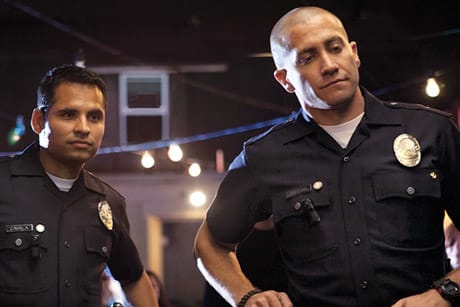End of Watch, the new film by David Ayer (Training Day, Harsh Times, Street Kings), is a pastiche of spy cam, camcorder, and cellphone footage. It does little to push forward the genre, what could only be described as hyperrealism (a la Paranormal Activity, Quarantine, and perhaps Jarhead), but by the same token it's subject matter is rather fitting for its style. Meaning, there is actual motivation behind Ayer's decision to shoot this film from the immediate perspective of its two cop heroes, Taylor (Jake Gyllenhaal) and Zavala (Michael Anthony Peña) ― besides budgetary concerns, that is.
Taylor and Zavala are partners, which in the world of South Central, L.A. ― where director Ayer was raised ― means they are also brothers. In fact, if you are not part of a brotherhood, whether that be a gang or the police force, then you are shit out of luck. Officer Taylor is trying to escape that life, so it seems. Story has it that he carries around a camcorder because he is studying to become a lawyer, a degree which allegedly requires an art elective: filmmaking. Zavala, on the other hand, has never tried his hand at college, or anything outside the box really, besides allowing his wife to stick her hand up his ass during coitus.
What's more, Zavala claims to have joined the police force because his (then) soon-to-be-wife hounded him at his work, and told him he'd make better money patrolling the streets than replacing mufflers, a tale which Taylor triesto take in stride; But ultimately he fails to do. Taylor, blowing off his scholarly pursuits (although he keeps filming), opts to dive headlong into his police work, and before you can say "boo," gets hitched to a young 'hydraulics' student by the name of Janet (Anna Kendrick). All choices (ill-conceived) which end up leading to his unit's demise; in roll the AKs, esses, gangstas, and cartel decapitations.
And so, if you're looking for a wild ride through the gritty street-life, fictional or not, of South Central, L.A., then look no further. And if you're looking for a disguised meditation on the invisible walls surrounding the ghettos of America, then look no further again. The reason why Ayer refuses to frame anything but the immediate action inside South Central is simple. It's because there is no 'outside' of South Central for its inhabitants. It takes no more than a few words between friends to get sucked in, and once you're in, you're as good as dead.
(Open Road)Taylor and Zavala are partners, which in the world of South Central, L.A. ― where director Ayer was raised ― means they are also brothers. In fact, if you are not part of a brotherhood, whether that be a gang or the police force, then you are shit out of luck. Officer Taylor is trying to escape that life, so it seems. Story has it that he carries around a camcorder because he is studying to become a lawyer, a degree which allegedly requires an art elective: filmmaking. Zavala, on the other hand, has never tried his hand at college, or anything outside the box really, besides allowing his wife to stick her hand up his ass during coitus.
What's more, Zavala claims to have joined the police force because his (then) soon-to-be-wife hounded him at his work, and told him he'd make better money patrolling the streets than replacing mufflers, a tale which Taylor triesto take in stride; But ultimately he fails to do. Taylor, blowing off his scholarly pursuits (although he keeps filming), opts to dive headlong into his police work, and before you can say "boo," gets hitched to a young 'hydraulics' student by the name of Janet (Anna Kendrick). All choices (ill-conceived) which end up leading to his unit's demise; in roll the AKs, esses, gangstas, and cartel decapitations.
And so, if you're looking for a wild ride through the gritty street-life, fictional or not, of South Central, L.A., then look no further. And if you're looking for a disguised meditation on the invisible walls surrounding the ghettos of America, then look no further again. The reason why Ayer refuses to frame anything but the immediate action inside South Central is simple. It's because there is no 'outside' of South Central for its inhabitants. It takes no more than a few words between friends to get sucked in, and once you're in, you're as good as dead.
